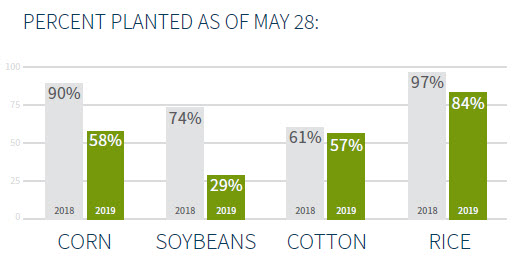This spring, floods throughout the Midwest as well as widespread rain events across much of the Midwest, the Delta region, and the Great Lakes region, have largely affected planting conditions causing delays in the field for farmers.
“Cooler temperatures have also contributed to some of the delays in combination with these rain events. The northern corn belt states have also had to deal with prolonged winter weather conditions pushing back their ability to get into their fields. The best parts of our writing area appear to be Texas, Kansas, parts of Nebraska, and then west,” said FMH Claims Manager and Vice President Aaron Rutledge.

As of May 28, the USDA’s Crop Progress report estimates that in the top 18 corn-producing states, only 58 percent of the acres had been planted, down significantly from 90 percent in 2018 and the five-year average of 90 percent planted.
For the top 18 soybean-producing states, planted acres are at 29 percent, down from 74 percent in 2018 and the five-year average of 66 percent. As for cotton and rice, the 15 top-producing cotton states sit at 57 percent planted, slightly below 61 percent in 2018 and the five-year average at 58 percent. The USDA estimates for the six top-producing rice states 84 percent are planted, down from 97 percent in 2018 and the five-year average of 96 percent.
Rutledge notes that the delays in planting have led to a lot of questions on prevented planting acres, which tops the list of concerns now. “The closer we get to the final planting date, the more we have to worry about conditions affecting the ability of the insured to get into the field to plant or get back into the field to replant,” he said.
He adds that the best thing agents can do now is to encourage communication with their insureds and making sure that adjusters are also kept in the loop. Before replanting or switching to another crop, it’s important that insureds contact their adjuster.


